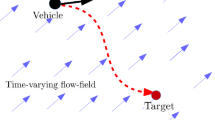Abstract
In this paper, the authors study the cooperative target-fencing problem for n-dimensional systems and a target with a general trajectory. Without using the velocity of the vehicles, a position feedback control law is proposed to fence the general target into the convex hull formed by the vehicles. Specifically, the dynamics of each vehicle is described by a double-integrator system. Two potential functions are designed to guarantee connectivity preservation of the communication network and collision avoidance among the vehicles. The proposed approach can deal with a target whose trajectory is any twice continuously differentiable function of time. The effectiveness of the result is verified by a numerical example.
Similar content being viewed by others
References
Drew D S, Multi-agent systems for search and rescue applications, Current Robotics Reports, 2021, 2(2): 189–200.
Mohiuddin A, Tarek T, Zweiri Y, et al., A survey of single and multi-UAV aerial manipulation, Unmanned Systems, 2020, 8(2): 119–47.
Dotoli M, Zgaya H, Russo C, et al., A multi-agent advanced traveler information system for optimal trip planning in a co-modal framework, IEEE Transactions on Intelligent Transportation Systems, 2017, 18(9): 2397–412.
Kopfstedt T, Mukai M, Fujita M, et al., Control of formations of UAVs for surveillance and reconnaissance missions, IFAC Proceedings Volumes, 2008, 41(2): 5161–5166.
Fedele G, D’Alfonso L, and Franzé G, Swarm formation for perimeter surveillance in rectangular strips: A distributed model predictive approach, Journal of the Franklin Institute, 2022, 359(18): 10578–10601.
Seyboth G S, Wu J, Qin J, et al., Collective circular motion of unicycle type vehicles with nonidentical constant velocities, IEEE Transactions on Control of Network Systems, 2014, 1(2): 167–176.
Shames I, Dasgupta S, Fidan B, et al., Circumnavigation using distance measurements under slow drift, IEEE Transactions on Automatic Control, 2012, 57(4): 889–903.
Deghat M, Shames I, Anderson B D O, et al., Localization and circumnavigation of a slowly moving target using bearing measurements, IEEE Transactions on Automatic Control, 2014, 59(8): 2182–2188.
Kim T H and Sugie T, Cooperative control for target-capturing task based on a cyclic pursuit strategy, Automatica, 2007, 43(8): 1426–1431.
Yu X and Liu L, Cooperative control for moving-target circular formation of nonholonomic vehicles, IEEE Transactions on Automatic Control, 2017, 62(7): 3448–3454.
Chen Z, A cooperative target-fencing protocol of multiple vehicles, Automatica, 2019, 107: 591–594.
Kou L, Chen Z, and Xiang J, Cooperative fencing control of multiple vehicles for a moving target with an unknown velocity, IEEE Transactions on Automatic Control, 2022, 67(2): 1008–1015.
Kou L, Huang Y, Chen Z, et al., Cooperative fencing control of multiple second-order vehicles for a moving target with and without velocity measurements, International Journal of Robust and Nonlinear Control, 2021, 31(10): 4602–4615.
Hu B B, Zhang H T, and Shi Y, Cooperative label-free moving target fencing for second-order multi-agent systems with rigid formation, Automatica, 2023, 148: 110788.
Hu B B, Chen Z, and Zhang H T, Distributed moving target fencing in a regular polygon formation, IEEE Transactions on Control of Network Systems, 2022, 9(1): 210–218.
Pan Z and Chen B M, Cooperative target fencing for a general target with connectivity preservation, Proceedings of 22nd IFAC World Congress, Yokohama, 2023, 2919–2924.
Francis B A, The linear multivariable regulator problem, SIAM Journal on Control and Optimization, 1977, 15(3): 486–505.
Han D and Panagou D, Robust multitask formation control via parametric Lyapunov-like barrier functions, IEEE Transactions on Automatic Control, 2019, 64(11): 4439–4453.
Huang Y, Meng Z, and Dimarogonas D V, Prescribed performance formation control for second-order multi-agent systems with connectivity and collision constraints, Automatica, 2024, 160: 111412.
Dong Y and Huang J, Flocking with connectivity preservation of multiple double integrator systems subject to external disturbances by a distributed control law, Automatica, 2015, 55: 197–203.
Dong Y and Huang J, Leader-following connectivity preservation rendezvous of multiple double integrator systems based on position measurement only, IEEE Transactions on Automatic Control, 2014, 59(9): 2598–2603.
Su Y and Huang J, Cooperative output regulation of linear multi-agent systems, IEEE Transactions on Automatic Control, 2012, 57(4): 1062–1066.
Author information
Authors and Affiliations
Corresponding author
Ethics declarations
The authors declare no conflict of interest.
Additional information
This research was supported in part by the Research Grants Council of Hong Kong SAR under Grant Nos. 14206821 and 14217922, and in part by the Hong Kong Centre For Logistics Robotics (HKCLR).
Rights and permissions
About this article
Cite this article
Pan, Z., Chen, B.M. Cooperative Target Fencing of Multiple Vehicles for a General Target with Connectivity Preservation and Collision Avoidance. J Syst Sci Complex 37, 136–151 (2024). https://doi.org/10.1007/s11424-024-3428-1
Received:
Revised:
Published:
Issue Date:
DOI: https://doi.org/10.1007/s11424-024-3428-1




